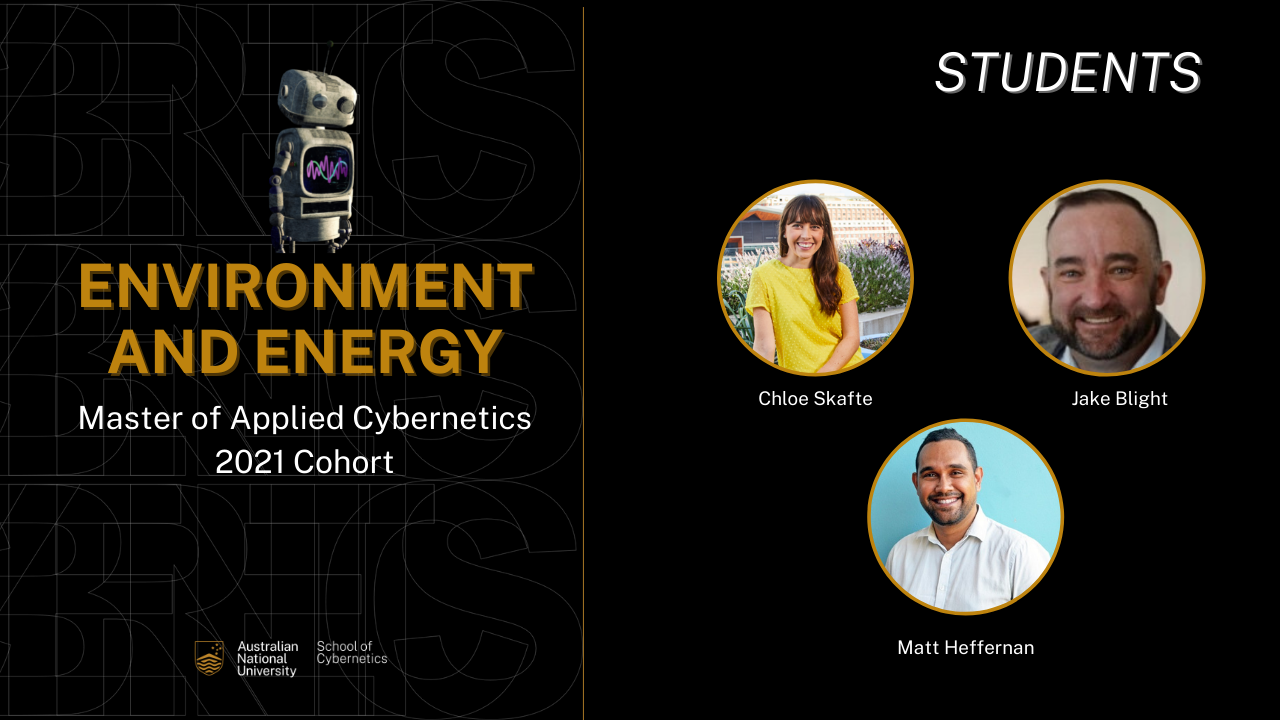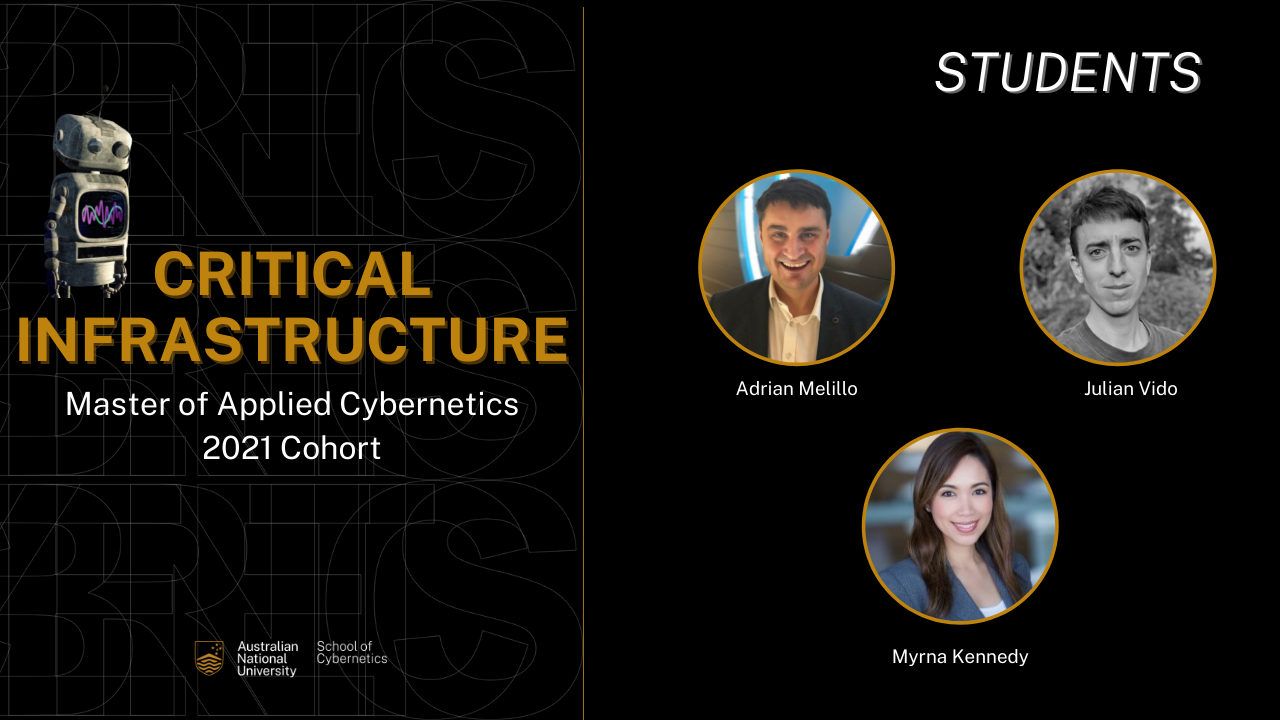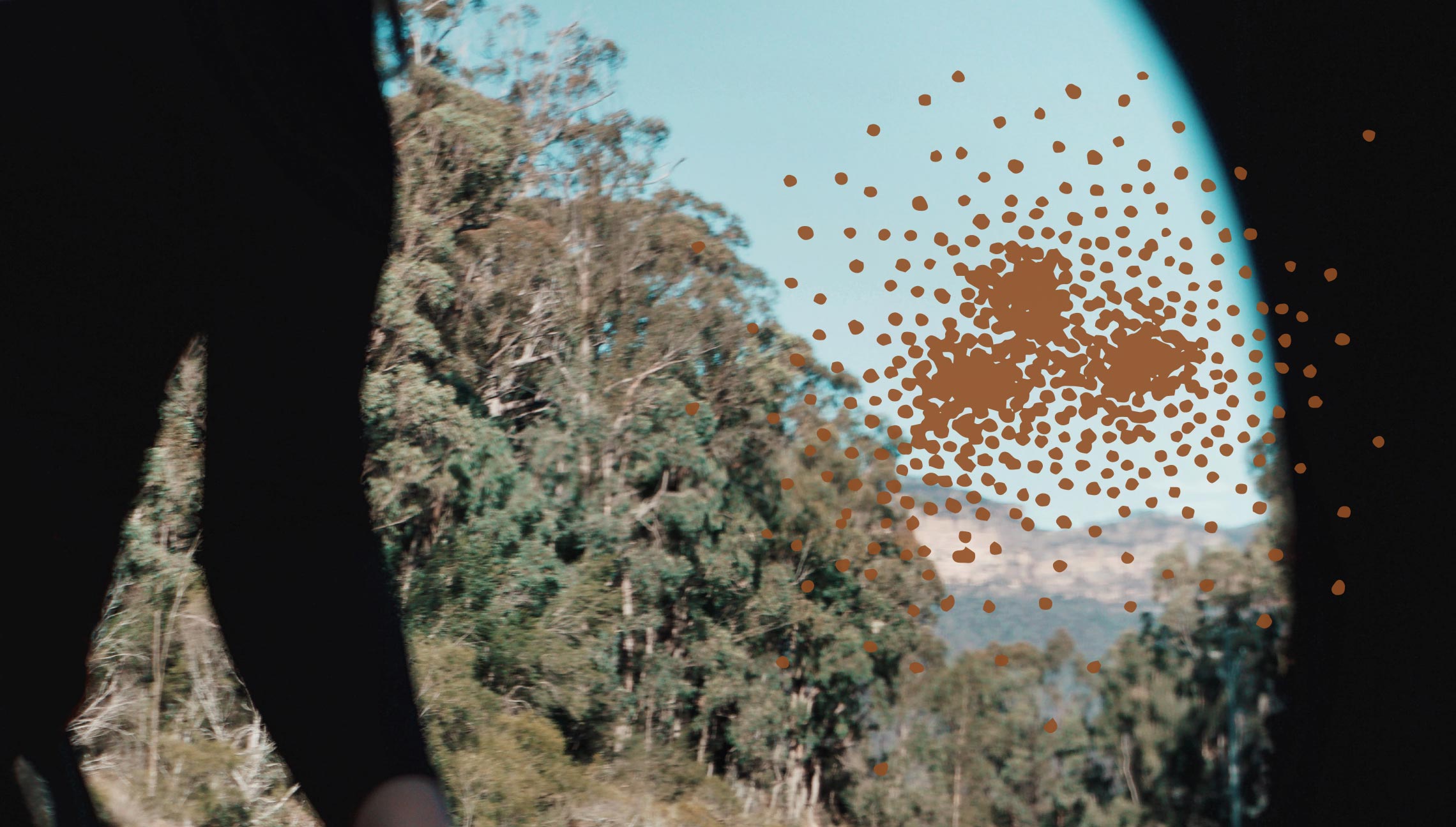Welcome to explore the work of our 2021 cohort — the third cohort in our Masters program.
For Demo Day 2021, students from the Master of Applied Cybernetics at the Australian National University will showcase their group projects from their Building Cyber-Physical Systems course. Students will exhibit the skills they’ve learned and developed across the year, along with their previous backgrounds and expertise, and explain how they have conceptualized, designed and created cyber-physical systems incorporating artificial intelligence, feedback loops, sensors and actuators, which have potential to scale in the world. This year, the students’ projects revolve around three themes: environment and energy, critical infrastructure, and health and well-being.
The Projects#
Environment and Energy#
The GLUG (Gas Leaks Under Ground) Rover is a cyber-physical system (CPS) used to check underground gas pipelines for leaks. The GLUG Rover is a terrestrial droid (4-wheel drive) that can work in a semi-autonomous manner to search along the route of an underground pipeline to identify the presence of a leak and, if it finds a likely leak, to narrow the search area where the ‘scent’ is strongest and make the presence of gas known to the operator. Different sensors can be supplied with the GLUG Rover to detect different chemical signatures including LPG, natural gas, methane, hydrogen, and petroleum products. GLUG can be assembled and deployed by communities and landholders with gas pipelines running beneath their land so that they can assure themselves that gas is not leaking into the environment. The design of the GLUG Rover was inspired by the way dogs use their extraordinary scenting ability and instinctive search patterns to identify the source of odours.

Matt Heffernan In my current role, I work as a developer and facilitator for Indigital. This includes creating bespoke applications to meet our client and or internal workflow needs (i.e. creating a web based voice recorder that saves files as an mp3 file, because schools didn’t always have requisite installed software to do this). I also facilitate training sessions with teachers remotely or onsite, this includes introducing them to Minecraft Education Edition, how to use the commands, how to access the programming interface and some basic concepts around programming. Proficiency with JavaScript, Node, React, React Native, Python, HTML, CSS, and tools such as BASH, Visual Studio Code, GitHub, Vim, and several Debian based Linux distributions.
Chloe Skafte Chloe is a VR/AR designer applying cybernetic concepts and biomimicry to create a regenerative future. She has six years’ experience working in emerging technology, leading the design and development of VR and AR applications in Finance and Real Estate and holds a Master of Applied Cybernetics and a B.IT. Chloe has shared her experience taking emerging technologies to scale by teaching the Developing VR/AR Strategy Course at RMIT Online. In 2018, she received the ACS Young ICT Professional of the Year Award and actively participates in mentoring STEM university students. Chloe is passionate about wildlife conservation and volunteers as a Wildlife Carer, caring for orphaned possum joeys.
Jake Blight Jake is a lawyer and senior executive. His experience covers some of the most sensitive areas of government. He been General Counsel in three agencies and the acting head of an integrity agency. Jake has led many major reviews and inquiries and advised on major operations. He has particular expertise in the areas of surveillance, security and statutory interpretation. Jake’s practical and pragmatic approach has made him a trusted advisor and leader. He has regularly appeared before Parliamentary Committees. Jake is also a volunteer firefighter and a keen dog trainer.
Critical Infrastructure#
Recent studies show that Australia generates more than 500,000 tonnes of e-waste, more than half of which is not recycled and goes straight to landfill. This causes significant damage to the environment, as toxic chemical and plastics slowly leach into the ecosystem. It is also a waste of valuable resources that can be recovered and reused as raw materials in manufacturing. Despite Australia having some of the most developed regulations to ensure manufacturers implement schemes to recycle their products, the uptake in Australia remains low. People continue to hoard old and disused technology in their home for reasons including that they do not know e-waste is recyclable or they don’t know where to take e-waste for recycling. Even worse, when they do recycle these products, they often end up in toxic waste dumps in developing countries when workers strip them for their valuable materials. To address these twin challenges, the Critical Infrastructure has designed a cyber-physical system known as the Smart Autonomous Recycling Cradle, or ‘SMARC’ for short.

Adrian Melillo Insightful technologist and Leader with deep knowledge of API, AI, security, data and cloud domains. Within technology companies, a senior executive with a track record of creating strategies necessary to grow multi-$M software and services businesses that support tangible business outcomes in their customer base. Energetic, passionate and commercially astute executive with a demonstrated track record in providing outstanding leadership ranging from large multi-nationals to mature startups. I have been fortunate to work with and lead amazing teams across sales, customer success, as well as technical consultancies at partner level.
Julian Vido I have a background in law and public policy and have worked across a range of sectors. During my years in legal practice, I worked in both corporate and community practices and developed particular expertise in the areas of employment law and mental health law. More recently, I have been working in public policy, with a focus on the protection of sacred sites in the Northern Territory. I am interested in creating a fairer and more equitable society through law reform and robust systems of public administration. In this regard, I am particularly drawn to the policy and legal questions that must be identified and answered to safely design for an autonomous world. As a part of the 3Ai Masters Program for 2021, I am excited to develop our thinking about the juncture between technology and public policy, so as to address inequality and prioritise advancements in social justice and community wellbeing.
Myrna Kennedy I have a pharmacy background and experience in customer service, project management and data analytics within the financial industry. I’m a fast learner with a growth mindset and passion for sustainability to improve humans’ well-being. I enjoy building/making things and volunteering in the community. Education and continuous improvement are the essential things that I always encourage my children to pursue. I’m motivated to make sure that our future generation can live in a sustainable environment and have excellent social-economy well-being through responsible and ethical Cyber-Physical Systems that we develop using advanced AI technologies.
Health and Wellbeing#
In today’s noisy, complex, and often distracted world, where technology not only brings people together but increasingly sets them apart, we wanted to offer people a mindful moment – to explore something new, inspire a sense of awe, wonder and presence, and remind ourselves of our connection to a global community. The result was artBeat. ArtBeat is a web-based digital artwork that uses the human heartbeat to bring a map of the world to life. Accessible to anyone with Internet and a digital device, artBeat was created with a global community in mind. Because artBeat is about using technology to connect people - not through their opinions or their relationship status - but through our shared experience of a beating heart. Of life. For those interested in more details, artBeat works by using two key pieces of information - i) heartbeat data uploaded by users, which has typically been measured using a wearable device (for instance we have been testing with an Empatica E4), and ii) the country that the user associates their heartbeat with. artBeat then takes these two pieces of information across multiple users to calculate an ‘average heartbeat’ for every country around the world. This ‘average heartbeat’ is then represented by speed of each country’s animated trace - a faster trace means a faster average heartbeat. We designed artBeat with data privacy as a central tenet, so by the time artBeat goes live to the public it will encrypt user-uploaded data and then delete it as soon as it has been used to recalculate the relevant country’s average heartbeat. The data won’t be used by artBeat for any other purposes and we won’t make it available to any third parties either.

Erika Ly Erika Ly is a Master of Applied Cybernetics student at the ANU School of Cybernetics. Erika is interested in the design of governance and assurance systems for technology development, implementation, and scale. Erika is also Director of The Legal Forecast, has worked in the Strategy team at Accenture, as a ‘Technolegal’ at Gilbert + Tobin, and in the Public Policy team for a large technology company. She holds a Bachelor of Laws and a Bachelor of Arts (Government and International Relations) with Honours from the University of Sydney.
James Liu James is currently studying a Master of Applied Cybernetics at the ANU School of Cybernetics. Prior to joining the 2021 Masters Cohort, James spent a number of years working in the social non-profit space bringing educational workshops to students in regional Australia and was also co-founder of a tech startup working on scalable wireless power. At present, James is interested in how the values and tools of applied cybernetics can be brought to bear in the contexts of venture capital and startups. He’s also (for better or worse) an avid writer of poetry.
Sarah O’Connor Sarah is a Master of Applied Cybernetics student at the ANU School of Cybernetics. Sarah holds a Bachelor of International Relations (Hons.) and Master of Laws in International Law (LLM) from the Australian National University (ANU). Sarah previously worked for the Australian Strategic Policy Institute (ASPI) as a researcher, covering cyber-enabled foreign interference, grey zone warfare and algorithmic bias. Sarah is interested in the integration of emerging technologies into various systems and the application of International Law, such as International Humanitarian Law (IHL) and Cyber Warfare Law, to these technologies in the context of armed conflict.
Kate Tollenaar Kate is an officer in the Australian Army with experience in the areas of technical communications, training, history, and strategy. She is delighted to be part of the third cohort of the Masters program at the School of Cybernetics. She holds a Bachelor (Honours) from UNSW and a Masters of Military and Defence Studies from ANU.

